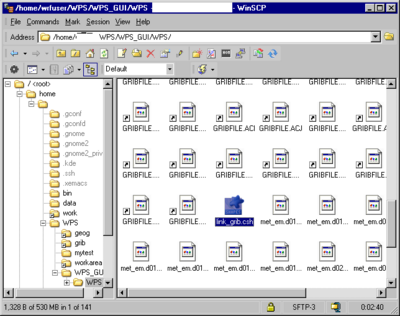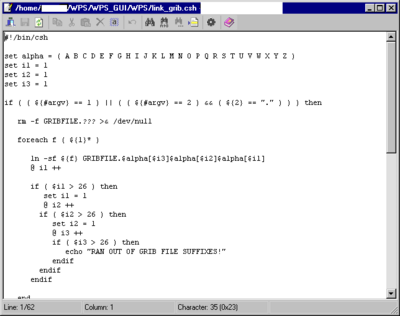Difference between revisions of "Remote Editing in UNIX"
| (2 intermediate revisions by the same user not shown) | |||
| Line 1: | Line 1: | ||
[[Image:WinSCP_explorer.png|thumb|The WinSCP Explorer|400px]] | |||
[[Image:WinSCP_editor.png|thumb|A Remote edit window|400px]] | |||
Unlike Windows, UNIX computers were always meant to be accessed both locally (in front of the computer) and remotely (from somewhere remote). Even with today's high speed network communications, editing with a graphical editor like [[wikipedia:gedit|gedit]] over the network can be a tedious experience. You hit a button and wait ages for the user interface to be updated!. Of course if you are comfortable with vim or emacs editors which don't need any graphical interface, they you are fine. But for those who don't know these, there is [[wikipedia:WinSCP|WinSCP]]. | Unlike Windows, UNIX computers were always meant to be accessed both locally (in front of the computer) and remotely (from somewhere remote). Even with today's high speed network communications, editing with a graphical editor like [[wikipedia:gedit|gedit]] over the network can be a tedious experience. You hit a button and wait ages for the user interface to be updated!. Of course if you are comfortable with vim or emacs editors which don't need any graphical interface, they you are fine. But for those who don't know these, there is [[wikipedia:WinSCP|WinSCP]]. | ||
==How it works== | ==How it works== | ||
Well.. rather simple. Let's think of a scenario. You can log in to a UNIX server in [[wikipedia:Tasmania|Tasmania]] and you live in [[wikipedia:Turkey]]. The network speed is so low that it is not possible to invoke a fancy editor that is available in the server. One thing you can do is to use [[wikipedia:FTP|FTP]] (or any other file transfer method) to get a copy of the file to your local (let's say windows) computer, edit the copy and send the new version back to the server. Problem solved! But this is a lot of work and if you want to edit 100 files and each file has to be edited dozen times, this is going to kill you! What [[wikipedia:WinSCP]] does is simply automate this entire process. | Well.. rather simple. Let's think of a scenario. You can log in to a UNIX server in [[wikipedia:Tasmania|Tasmania]] and you live in [[wikipedia:Turkey|Turkey]]. The network speed is so low that it is not possible to invoke a fancy editor that is available in the server. One thing you can do is to use [[wikipedia:FTP|FTP]] (or any other file transfer method) to get a copy of the file to your local (let's say windows) computer, edit the copy and send the new version back to the server. Problem solved! But this is a lot of work and if you want to edit 100 files and each file has to be edited dozen times, this is going to kill you! What [[wikipedia:WinSCP|WinSCP]] does is simply automate this entire process. | ||
There is a [[wikipedia:Windows Explorer]] like interface that shows files in the remote server and when you double click on a file it will be copied to your local machine and opened in the editor. Whenever you hit the 'Save' button on the editor, the program updates the changes in the remote copy on the server. | There is a [[wikipedia:Windows Explorer|Windows Explorer]] like interface that shows files in the remote server and when you double click on a file it will be copied to your local machine and opened in the editor. Whenever you hit the 'Save' button on the editor, the program updates the changes in the remote copy on the server. | ||
;WinSCP website: [http://winscp.net winscp.net] | ;WinSCP website: [http://winscp.net winscp.net] | ||
Latest revision as of 18:57, 2 November 2007
Unlike Windows, UNIX computers were always meant to be accessed both locally (in front of the computer) and remotely (from somewhere remote). Even with today's high speed network communications, editing with a graphical editor like gedit over the network can be a tedious experience. You hit a button and wait ages for the user interface to be updated!. Of course if you are comfortable with vim or emacs editors which don't need any graphical interface, they you are fine. But for those who don't know these, there is WinSCP.
How it works
Well.. rather simple. Let's think of a scenario. You can log in to a UNIX server in Tasmania and you live in Turkey. The network speed is so low that it is not possible to invoke a fancy editor that is available in the server. One thing you can do is to use FTP (or any other file transfer method) to get a copy of the file to your local (let's say windows) computer, edit the copy and send the new version back to the server. Problem solved! But this is a lot of work and if you want to edit 100 files and each file has to be edited dozen times, this is going to kill you! What WinSCP does is simply automate this entire process.
There is a Windows Explorer like interface that shows files in the remote server and when you double click on a file it will be copied to your local machine and opened in the editor. Whenever you hit the 'Save' button on the editor, the program updates the changes in the remote copy on the server.
- WinSCP website
- winscp.net

